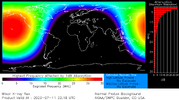THE BASTILLE DAY EVENT: You know a solar flare is strong when even the Voyager spacecraft feel it. Twenty-three years ago today (July 14, 2000), the sun exploded with so much force it sent shockwaves to the edge of the solar system.
Above: SOHO images of the X5.7-class Bastille Day solar flare (left) and CME (right). Blinding "snow" in the images is a result of energetic protons hitting the spacecraft
At about 11 a.m. in western Europe, where Bastille Day celebrations were underway in France, Earth-orbiting satellites reported an X5.7-class solar flare. Within the hour, energetic particles accelerated by the flare reached our planet. Protons and electrons hit the atmosphere and created a cascade of radiation that reached all the way to the ground--a rare "
GLE."
"People flying in commercial jets at high latitudes would have received double their usual radiation dose," says Clive Dyer of the University of Surrey Space Centre in Guildford UK, who studies extreme space weather. "It was quite an energetic event--one of
the strongest of the past 20 years."
A day later the CME arrived. Its impact on July 15, 2000, sparked an extreme (Kp=9) geomagnetic storm. The sun had just set on the east coast of North America when the auroras appeared.
 Red auroras over Troutman, North Carolina, on July 15, 2000. Credit: Ronnie Sherrill
Red auroras over Troutman, North Carolina, on July 15, 2000. Credit: Ronnie Sherrill
"I was out in the yard doing chores and saw bright red auroras overhead," recalls Uwe Heine of Caswell County, North Carolina. "I called over to our neighbor, Carrie, who was also outside. I told her those were not sunset colors. It was an aurora, and super rare to see this far south!"
In New York, the sky exploded with light, recalls Lou Michael Moure. "I was living on Long Island at the time. A family member came running into my room, begging me to come outside to see 'the sky on fire.' Hues of white and green eventually gave way to reds that blanketed the heavens from horizon to horizon."
By the time the storm subsided on July 16, 2000, auroras had been reported as far south as Texas, Florida and Mexico.
The Bastille Day Event is special to researchers. It was the first major solar storm after the 1995 launch of SOHO, the Solar and Heliospheric Observatory. Data from the young satellite taught researchers a lot, very quickly, about the physics of extreme flares.
 Above: A modern MHD computer simulation of the Bastille Day explosion. Credit: Tibor Török et al., The Astrophysical Journal, 856:75 (22pp), 2018 March 2
Above: A modern MHD computer simulation of the Bastille Day explosion. Credit: Tibor Török et al., The Astrophysical Journal, 856:75 (22pp), 2018 March 2
Tibor Török of Predictive Science, Inc., is one of many researchers still studying the Bastille Day Event. He recently applied a modern magnetohydrodynamic (MHD) computer model to some of the data, and found that 1033 ergs of magnetic energy were released in the explosion--about the same as a thousand billion WWII atomic bombs.
No wonder the Voyagers felt it.
It took the Bastille Day CME months to reach the distant spacecraft--180 days to Voyager 2, and 245 days to Voyager 1. Being near the edge of the solar system, both spacecraft were normally bathed in high levels of cosmic rays. The CME
swept aside that ambient radiation, creating a temporary reduction called a "Forbush Decrease." Conditions did not return to normal until 3 to 4 months later. Finally, the storm was over.











